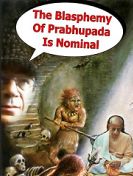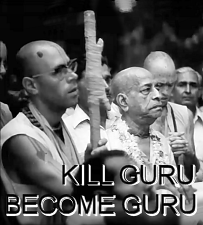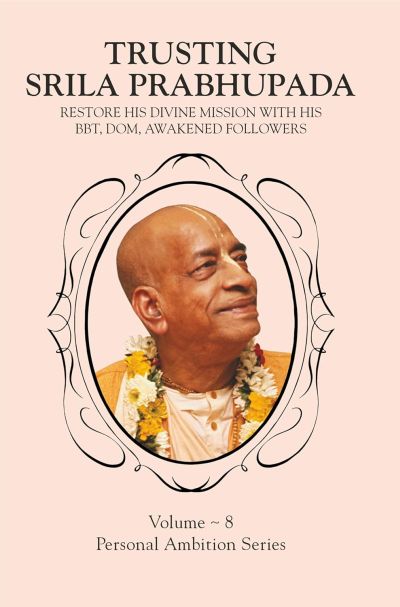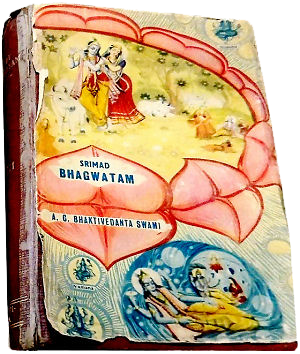By Yashodanananda Das
sri-virabhadra gosani–skandha-mahasakha
tanra upasakha yata, asankhya tara lekha
After Nityananda Prabhu, the greatest branch is Virabhadra Gosani, who also has innumerable branches and subbranches. It is not possible to describe them all.
Srila Bhaktisiddhanta Sarasvati Thakura describes VirabhadraGosani as the direct son of Srila NityanandaPrabhu and a disciple of Jahnava-devi. His real mother was Vasudha. In the Gaura-ganoddesa-dipika, verse 67, he is mentioned as an incarnation of Ksirodakasayi Visnu. Therefore VirabhadraGosani is nondifferent from Sri Krsna Caitanya Mahaprabhu. In a village of the name Jhamatapura, in the district of Hugali, VirabhadraGosani had a disciple named Yadunathacarya, who had two daughters-a real daughter named Srimati and a foster daughter named Narayani.
Both these daughters married, and they are mentioned in Bhakti-ratnakara (Thirteenth Wave). VirabhadraGosani had three disciples who are celebrated as his sons-Gopijana-vallabha, Ramakrsna and Ramacandra. The youngest, Ramacandra, belonged to the Sandilya dynasty and had the surname Vatavyala. He established his family at Khadadaha, and its members are known as the gosvamis of Khadadaha. The eldest disciple, Gopijana-vallabha, was a resident of a village known as Lata, near the Manakara railway station in the district of Burdwan.
The second, Ramakrsna, lived near Maladaha, in a village named Gayesapura. Srila Bhaktisiddhanta Sarasvati Thakura notes that since these three disciples belonged to different gotras, or dynasties, and also had different surnames and lived in different places, it is not possible to accept them as real sons of VirabhadraGosani. Ramacandra had four sons, of whom the eldest was Radhamadhava, whose third son was named Yadavendra. Yadavendra’s son was Nandakisora, his son was Nidhikrsna, his son was Caitanyacanda, his son was Krsnamohana, his son was Jaganmohana, his son was Vrajanatha, and his son was Syamalala Gosvami. This is the genealogical table given by Bhaktisiddhanta Sarasvati Thakura for the descendants of Virabhadra Gosani
Books : Sri Caitanya-caritamrta – 1975 Edition : Cc. Adi-lila : Adi 11: The Expansions of Lord Nityananda : Adi 11.8 :
About one and a half miles away from Kumarahatta, or Kamarhatta, which is a few miles from Calcutta, is a village known as Kancadapada which was the home of Sri Sivananda Sena. There he constructed a temple of Sri Gauragopala. Another temple was established there with Sri Radha-Krsna murtis by Srinatha Pandita. The Deity of that temple is named Sri Krsna Raya. The temple of Krsna Raya, which was constructed in the year 1708 sakabda (A.D. 1787) by a prominent Zamindar named Nimai Mullik of Pathuriya-ghata in Calcutta, is very large.
There is a big courtyard in front of the temple, and there are residential quarters for visitors and good arrangements for cooking prasada. The entire courtyard is surrounded by very high boundary walls, and the temple is almost as big as the Mahesa temple. Inscribed on a tablet are the names of Srinatha Pandita and his father and grandfather and the date of construction of the temple. Srinatha Pandita, one of the disciples of Advaita Prabhu, was the spiritual master of the third son of Sivananda Sena, who was known as Paramananda Kavi-karnapura.
It is said that during the time of Kavi-karnapura the Krsna Raya Deity was installed. According to hearsay, Virabhadra Prabhu, the son of Nityananda Prabhu, brought a big stone from Mursidabad from which three Deities were carved-namely, the Radhavallabha vigraha of Vallabhapura, the Syamasundara vigraha of Khadadaha and the Sri Krsna Raya vigraha of Kancadapada. The home of Sivananda Sena was situated on the bank of the Ganges near an almost ruined temple.
It is said that the same Nimai Mullik of Calcutta saw this broken-down temple of Krsna Raya while he was going to Benares and thereafter constructed the present temple.Books : Sri Caitanya-caritamrta – 1975 Edition : Cc. Adi-lila : Adi 10: The Trunk, Branches and Subbranches of the Caitanya Tree : Adi 10.10
isvara ha-iya kahaya maha-bhagavata
veda-dharmatita hana veda-dharme rata
Although Virabhadra Gosani was the Supreme Personality of Godhead, He presented Himself as a great devotee. And although the Supreme Godhead is transcendental to all Vedic injunctions, He strictly followed the Vedic rituals.
Books : Sri Caitanya-caritamrta – 1975 Edition : Cc. Adi-lila : Adi 11: The Expansions of Lord Nityananda : Adi 11.9
antare isvara-cesta, bahire nirdambha
caitanya-bhakti-mandape tenho mula-stambha
He is the main pillar in the hall of devotional service erected by Sri Caitanya Mahaprabhu. He knew within Himself that He acted as the Supreme Lord Visnu, but externally He was prideless.
CC Adi-Lila 11.10
adyapi yanhara krpa-mahima ha-ite
caitanya-nityananda gaya sakala jagate
It is by the glorious mercy of Sri Virabhadra Gosani that people all over the world now have the chance to chant the names of Caitanya and Nityananda
Books : Sri Caitanya-caritamrta – 1975 Edition : Cc. Adi-lila : Adi 11: The Expansions of Lord Nityananda : Adi 11.11
sei virabhadra-gosanira la-inu sarana
yanhara prasade haya abhista-purana
I therefore take shelter of the lotus feet of Virabhadra Gosani so that by His mercy my great desire to write Sri Caitanya-caritamrta will be properly guided.
Books : Sri Caitanya-caritamrta – 1975 Edition : Cc. Adi-lila : Adi 11: The Expansions of Lord Nityananda : Adi 11.12
sarvasakha-srestha virabhadra gosani
tanra upasakha yata, tara anta nai
Among all the branches of Sri Nityananda Prabhu, Virabhadra Gosani was the topmost. His subbranches were unlimited.
Books : Sri Caitanya-caritamrta – 1975 Edition : Cc. Adi-lila : Adi 11: The Expansions of Lord Nityananda : Adi 11.56
Lectures : Srimad-Bhagavatam Lectures : Canto 1: Lectures : SB 1.7: Lectures : Srimad-Bhagavatam 1.7.45-46 — Vrndavana, October 5, 1976 : 761005SB.VRN :
Then, tad dharmajna maha-bhaga bhavadbhir gauravam kulam. One should act in such a way that it should be glorified in the family. The family consideration is very important in Vedic culture. A family does not mean that only a husband, wife, or a few children. No. Family means the generation.
That is Vedic conception. So if something is wrong done by any member of the family, that becomes a scar to the whole family. So she is, from family-wise, she is warning that “Do not do anything which will be a discredit to the whole Pandava family.” Vrjinam narhati praptum pujyam vandyam abhiksnasah. So the guru and the guru’s family, they do not require to be chastised or punished. It has been misused in so many ways.
In Bengal… Just like they say nityananda-vamsa. Coming from Nityananda. So Nityananda had one son, Virabhadra. But Virabhadra did not marry. So there is no dynasty by semina. By nityananda-vamsa means by disciplic succession. So sometimes extra advantage was taken as nityananda-vamsa. But people have got respect for such thing, dynasty.
So not only it is now, from time immemorial, guru, guru’s dynasty… Even in Mohammedan religion there is such sentiment, Mohammed and his dynasty, Hussain, they are taken very respectfully. So considering all points, the guru’s respect must be maintained. This is the sum and substance of the instruction. But there is other opposite instruction also.







I find this very significant in the article which reads as ; ” Srila Bhaktisiddhanta Sarasvati Thakura describes VirabhadraGosani as the direct son of Srila NityanandaPrabhu and a disciple of Jahnava-devi. ……….. ”
Srila VirabhadraGosani is the disciple of Jahnava devi.
Does this not mean that Guru Mata Jahnava devi had Her own disciplic succession ?
pamho agtACBSP, SRI VIRABHADRA GOSANI TITOBHAV MAHOTSAVA KI JAI!
Such exalted Vaishnava qualities can be found only in SRI VIRABHADRA GOSANI.
In India there is still confusion regarding this Nityananda-vamsa. In Vrindavan they claim to belong to Nityananda-vamsa and collect guru daksina with the help of “videshi disciples”.
Actually we are all sons of SRI VIRABHADRA GOSANI because without HIS mercy we could not chant Hare Krsna in the mood of Lord Caitanya (vipralamba, mood of separation).
Everyone should take example of the sublime transcendental teachings of SRI VIRABHADRA GOSANI. He is a great personality but presents himself as very insignificant and thus make us to understand the importance to meditate on the lives of the exalted Brahma Gaudiya sampradaya Vaisnava qualities.
It is our main principle in Krsna consciousness to follow the example of previous acaryas who are completely free from all false designations – sarvopadhi – and today we are glad to glorify SRI VIRABHADRA GOSANI TIROBHAVA MAHOTSAV KI JAI,
agtSP ys
haribol